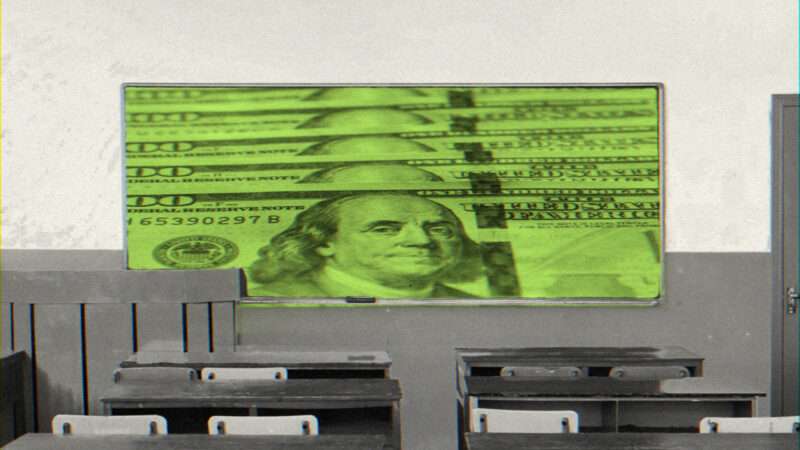
A viral TikTok video of Carmel High School outside Indianapolis, Indiana, has sparked a revealing conversation about school funding and school performance. The video, which had over 34 million views on TikTok and Twitter as of Wednesday morning, shows a group of students giving a tour of their massive and well-manicured suburban campus. The public school's facilities include a sizeable gleaming auditorium, an auto shop, and a planetarium.
Critics quickly argued that Carmel's schools must be better funded than worse-performing Indianapolis City Schools. "[W]hen you see this and then look at the other 'publicly funded' high schools in indianapolis, you realize just how blatantly racist indiana is," wrote one Twitter user in a post with over 9 million views.
"A lot of us know very well what it's like to go to high schools primarily made up of trailers while knowing that those in rich neighborhoods had state of the art facilities," another user posted.
However, Carmel High School spends significantly less per pupil than public high schools in Indianapolis. According to the Indiana Department of Education, Carmel High School in 2020 spent between $3,500 to $6,000 less per pupil compared to the four public high schools in Indianapolis.
Even with this massive spending gap, there are marked differences in performance. At Carmel High School, 71 percent of students are proficient in math, and 89 percent are proficient in reading; in Indianapolis City Schools, only 6 and 26 percent are proficient in math and reading, respectively. Indianapolis public high schools are failing—but it isn't for a lack of money.
As it turns out, the correlation between funding and school quality is extremely weak. According to one 2012 report from Harvard and Stanford researchers, "On average, an additional $1000 in per-pupil spending is associated with an annual gain in achievement of one-tenth of 1 percent of a standard deviation. But that trivial amount is of no statistical or substantive significance."
Further, one 2019 analysis of National Assessment of Educational Progress test scores found that "six of the top 10 states that improved their average test scores on the NAEP the most were among the 11 states with the smallest funding growth. Conversely, New York made the same progress as Michigan while revenues grew by nearly $10,000 a student, a 76 percent increase in raw dollars. Michigan's unadjusted funding growth over the period was 26 percent."
The comparison is even starker when looking at state-by-state examples. In 2019, Utah spent the least on education in the U.S.—with just $7,811 per pupil, according to US News & World Report. Neighboring Wyoming spent almost $10,000 more per student—shelling out an average of $17,018 per pupil. Despite this gap, the two states have remarkably similar student performance. Forty-four percent of Wyoming's 4th graders are proficient or better in math, compared to 42 percent of Utah's 4th graders. In reading, 38 percent of Wyoming's 4th graders are proficient or better, while 37 percent of Utah's 4th graders are. It's not apparent what the thousands of dollars in extra funding are doing in Wyoming public schools—but it doesn't appear to help students learn better.
Why doesn't more money always help schools improve? Mainly, the answer is that failing yet well-funded schools often simply aren't spending their money wisely.
"More money can help schools succeed, but not if they fritter those extra resources in unproductive ways," Jay Greene, a senior research fellow at the Heritage Foundation, told Reason. "There is no one formula for how to spend money correctly in schools. But there are many common ways that schools blow resources. Wasteful schools tend to hire more non-instructional staff while raising the pay and benefit costs for all staff regardless of their contribution to student outcomes. If you fully disconnect compensation from performance, you can raise salaries and benefits endlessly without anyone learning more."
While making good spending choices can help close some of the gap between affluent and non-affluent schools, it's worth noting that student poverty has a large effect on school performance. At Carmel High School, for example, only 10 percent of students are eligible for free or reduced-price lunches. At George Washington Community High School in Indianapolis, 66 percent of students are eligible.
Often, these challenges are difficult for schools to address, as low-income children often face a disadvantage long before they begin school. For example, one report from the Brookings Institution found that almost half of all low-income children are not ready to start school at age five. Thus, it's unlikely that two schools with very different student populations can end up with the same results—no matter how much money gets spent.
That said, a high concentration of low-income students doesn't necessarily mean that a school is bound to be low-performing. Many charter schools outperform local public schools even with much lower per-pupil spending—and, in many cases, more low-income students. The difference is that charter schools are incentivized to make good fiscal decisions because parents can leave if they feel their child's needs aren't being met.
"Because charter schools are more accountable to parents for results, they tend to use their uses more effectively in ways that accomplish the results parents are seeking," Greene added.
As long as parents—especially low-income parents without the ability to move to another school district—only have the option of sending their child to a local public school, it's difficult to imagine irresponsible spending habits changing anytime soon.
"Unfortunately, existing public school systems have practices and policies that tend to divert extra money to things that do not improve student outcomes," Green says. "Some schools, especially in the private and charter sectors where they are more accountable to parents for results, have adopted better practices and policies that get more bang for the educational buck, which is why we can see some very high-performing schools that spend relatively little."
The post Bad Schools Aren't Always Underfunded appeared first on Reason.com.







